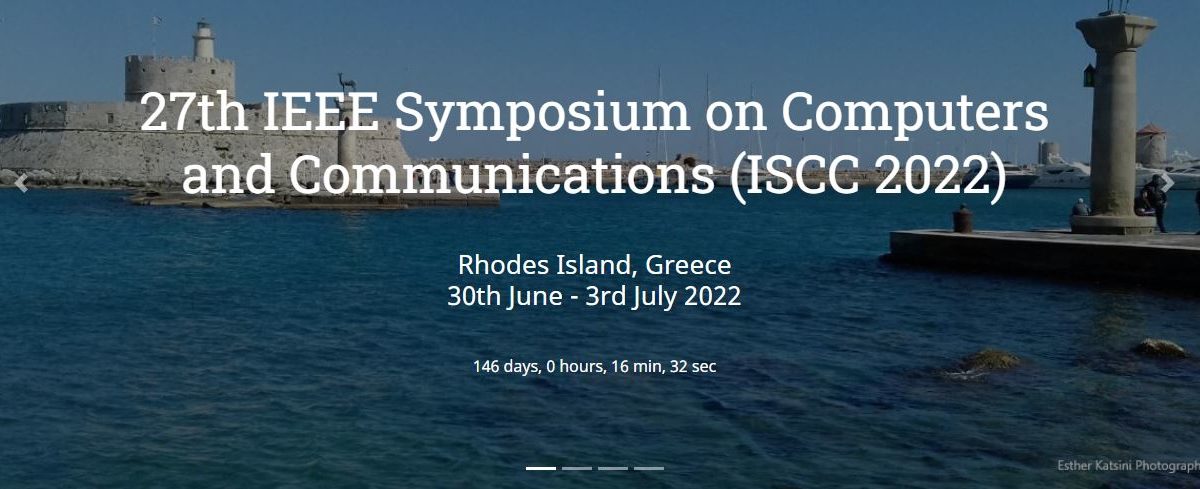Welcome to the 27th IEEE Symposium on Computers and Communications (ISCC).
The first IEEE Symposium on Computers and Communications (ISCC) was held in 1995 in response to the growing interaction between the fields of computers and communications.
ISCC takes place annually, usually in the Mediterranean region, in locations such as Egypt, Greece, France, Tunisia, Portugal, Spain, Morocco, Italy, and Brazil. In 2022, the Symposium is going to take place in Rhodes Island, Greece.
ISCC sessions will include presentations on new research results and tutorials. Papers describing original works are invited in any of the computer and communications areas covered by the Call for Papers. Accepted papers will be included in the ISCC 2022 Conference Proceedings, which will be subject to independent peer-review procedures for quality, and may be eligible for inclusion in the IEEE Xplore® Digital Library. Merit, relevance, and originality will guide paper acceptance. Best Paper Award and Best Student Paper Awards will be presented.
===========================
Important Dates
===========================
Paper submission deadline : February 7th, 2022
Notification of paper acceptance: April 15th, 2022
Submission of camera-ready papers due: May 6th, 2022
Conference Dates: end of June / beginning of July 2022
===========================
Call for Papers
===========================
ISCC 2022, in its 27th edition, will provide an insight into the unique world stemming from the interaction between the fields of computers and communications. ISCC 2022 will provide an international technical forum for experts from industry and academia to exchange ideas and present results of on-going research in most state-of-the-art areas of computers and communications. You are invited to submit a full paper, a proposal for a Panel/Invited Session or a Tutorial, related to the following topics of interest:
5th Generation Networks (5G) Resource Allocation
Network Slicing
Topology Management
5G Core Network and Service Based Architecture
C-RAN and backhaul
SDN and NFV for 5G
Network Stability, Control and Optimization
Standardization Activities by IEEE, 3GPP and ETSI
Security and Privacy
Privacy / Anonymity
Attacks and Defenses
Authentication, Authorization and Accounting
Hardware Security
Intrusion Detection
Moving Target Defense (MTD)
Blockchain
Internet of Things (IoT)
LPWAN (LoRa, Sigfox, NB-IoT, LTE-M, Wi-SUN)
6TiSCH, 6LoWPAN, Roll
Rest API, CoAP, CBOR, OSCORE
Operating Systems
Interoperability of IoT protocols and devices
Simulation, emulation and testbed support
Smart Spaces: design and applications
Cyber Physical Systems
Telecare Medical Information System
TinyML designed for microcontrollers and IoT-ready devices
Vehicular Networks
Intelligent Transport Systems (ITS)
IEEE 802.11p ITS-G5
Millimeter Waves
V2X, V2I, V2N, V2V, V2P, V2D, V2G
Inter and intra vehicle communication and protocols
Software Defined *
Software Defined Networks and Network Function Virtualization
Software Defined Smart Objects
Software Defined Data Centers
Software Defined Radio
Overlay and Programmable Networks
Artificial Intelligence (AI)
Artificial Intelligent Systems applications in Computers and Communications
AI Technologies
Game Theory
Machine and Deep Learning of Knowledge
Bio-inspired Computing in Communications
Data Science and Data Engineering
Distributed Knowledge and Processing
Cloud and Edge Computing
Cloud Computing (IaaS, PaaS, and SaaS)
Mobile Cloud and Mobile Cloud Networking
Fog Computing
Distributed Systems Architecture and Management
Wireless Networks
Cognitive Radio Networking
Wireless, Cellular, and Mobile Communications
Modeling and Simulation
Signal Processing for Communications
Services and Protocols
Advances in Internet Protocols
Green Networking
Real Time Communication Services
Routing and Multicast
Network Design, Optimization and Management
Network Reliability, Quality of Service and Quality of Experience
Fault-Tolerance and Error Recovery
Web Services and Service Oriented Architectures
Standards Evolution
Digital Satellite Communications Service
Localisation Protocols
Communications Services and Management
Crowdsourcing applications, Crowdsensing and Mobile CrowdSensing
Social Networks
Optical Networks
Optical Network Protocols and Architectures
Energy-efficient/green Optical Communications and Networks
Visible Light Communications (Indoor, Outdoor and Localization)
Optical Wireless Communication Applications for Future Networks
Application domain / Framework / Architecture
e-Health and Bioinformatics
Smart Grid
Smart City
Industry 4.0
Smart Building
Software Engineering
Peer-to-Peer Computing
Computing applications
Big Data, Data Mining and Database Applications
===========================
Submission Guidelines
===========================
Papers must be submitted electronically as a PDF file through the
conference management system, at:
https://edas.info/N29322
Please note:
(1) All papers will be reviewed by the Technical Program Committee on
the basis of technical quality, relevance, originality, significance,
and clarity. All paper submissions will be handled electronically.
Papers that do not comply with the Submission Guidelines will be
rejected without review.
(2) All papers should be submitted electronically in PDF and be no
longer than 7 pages in the IEEE double column proceedings format
including tables, figures and references. Papers exceeding 7 pages will
not be accepted. Download manuscript templates for IEEE conference
proceedings: https://www.ieee.org/conferences/publishing/templates.html
(3) Best Paper Award and Best Student Paper Awards will be presented.
(4) Accepted papers up to 6 pages will be published with no additional charge. Exceeding page(s) will be charged an additional fee.
(5) At least one author of each accepted paper is required to register to the conference and present the paper. Only registered and presented papers will be published in the conference proceedings. Accepted papers will be included in the ISCC 2021 Proceedings and will be submitted for inclusion to IEEE Xplore.
The ISCC Proceedings have been indexed in the past by ISI, dblp and Scopus. This makes the ISCC conference one of the publication venues with very high visibility and impact in both Computer and Communications areas.


Social Media